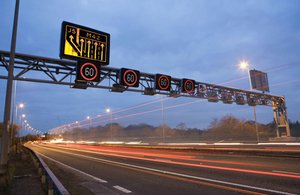Testing starts for innovative Warrington motorway trial
Tests have begun this week on an innovative, pilot project designed to reduce congestion along the M62 near Warrington in Cheshire.

Highways England is delivering the project at Croft Interchange - where junction 21a of the M6 meets junction 10 of the M62 – to give drivers smoother and more reliable journeys along the eastbound M62, one of the busiest commuter congestion hotspots in the region.
When the testing is completed in December / January, electronic information signs and variable mandatory speed limits on the M62, will combine with traffic lights on the motorway link roads from the M6, to provide smoother traffic flows.

Electronic signs on the eastbound M62 will be used with traffic lights on link road slip roads from the M6 to smooth drivers' journeys
Andy Withington, Highways England’s programme delivery manager for the North West, said:
This is an opportunity to combine existing technology and traffic management systems in a novel way to see whether we can give drivers using the frequently congested eastbound M62, lower journey times during peak hours and smoother, more reliable journeys.
Once the system is fully up and running we’ll be monitoring its use over a period of up to a year. If it is successful – and we believe it will be – it could well be used on other motorway to motorway link roads across the country.

At peak times drivers leaving the M6 may be required to stop at traffic lights at the end of the slip road onto the eastbound M62
The new motorway to motorway system will be introduced in 2 phases. The electronic variable message signs will be introduced first and drivers travelling between junction 9 and junction 11 of the eastbound M62 will start to see the signs in operation displaying mandatory variable speed limits and other information such as warnings of congestion.
The second phase of the scheme will see the traffic lights switched on at the end of the link roads onto the eastbound M62. Traffic leaving the M6 will be closely monitored and the lights will be controlled to minimise queuing onto the M6.
Mr Withington said:
The key aim of the project is to test the novel technology introduced through this pilot project and tackle congestion at peak travel times, especially during the morning rush hour. The link road traffic lights won’t be on all of the time, being limited to the morning peak, but the variable speed limit signs on the M62 eastbound will be working all the time when traffic conditions dictate.
Therefore, when the system is operating, drivers will be expected to obey the traffic lights on the link roads and variable mandatory speed limits displayed on the new M62 electronic signs.

Slip road signs have been installed to warn drivers of new traffic lights
The £7 million construction project involved installing some of the largest gantries ever used in the region to carry the electronic signs – crossing up to 10 lanes of traffic.
Money for the project is coming from a £150 million innovation fund, part of the £15 billion allocated to Highways England in the Government’s 2015 to 2020 Road Investment Strategy. The innovation fund is designed to encourage Highways England to look at new technology or novel techniques to improve journeys.
General enquiries
Members of the public should contact the Highways England customer contact centre on 0300 123 5000.
Media enquiries
Journalists should contact the Highways England press office on 0844 693 1448 and use the menu to speak to the most appropriate press officer.